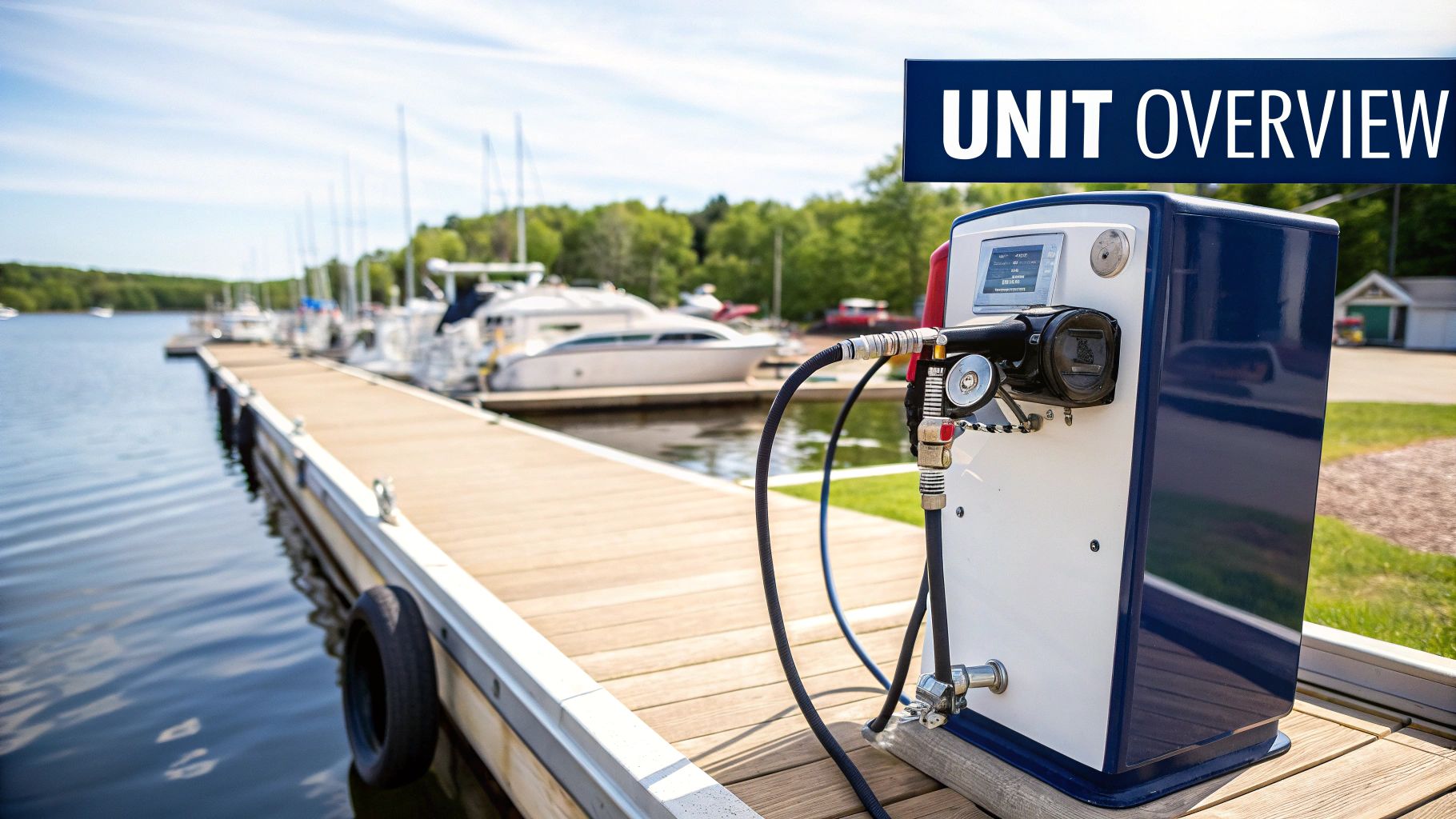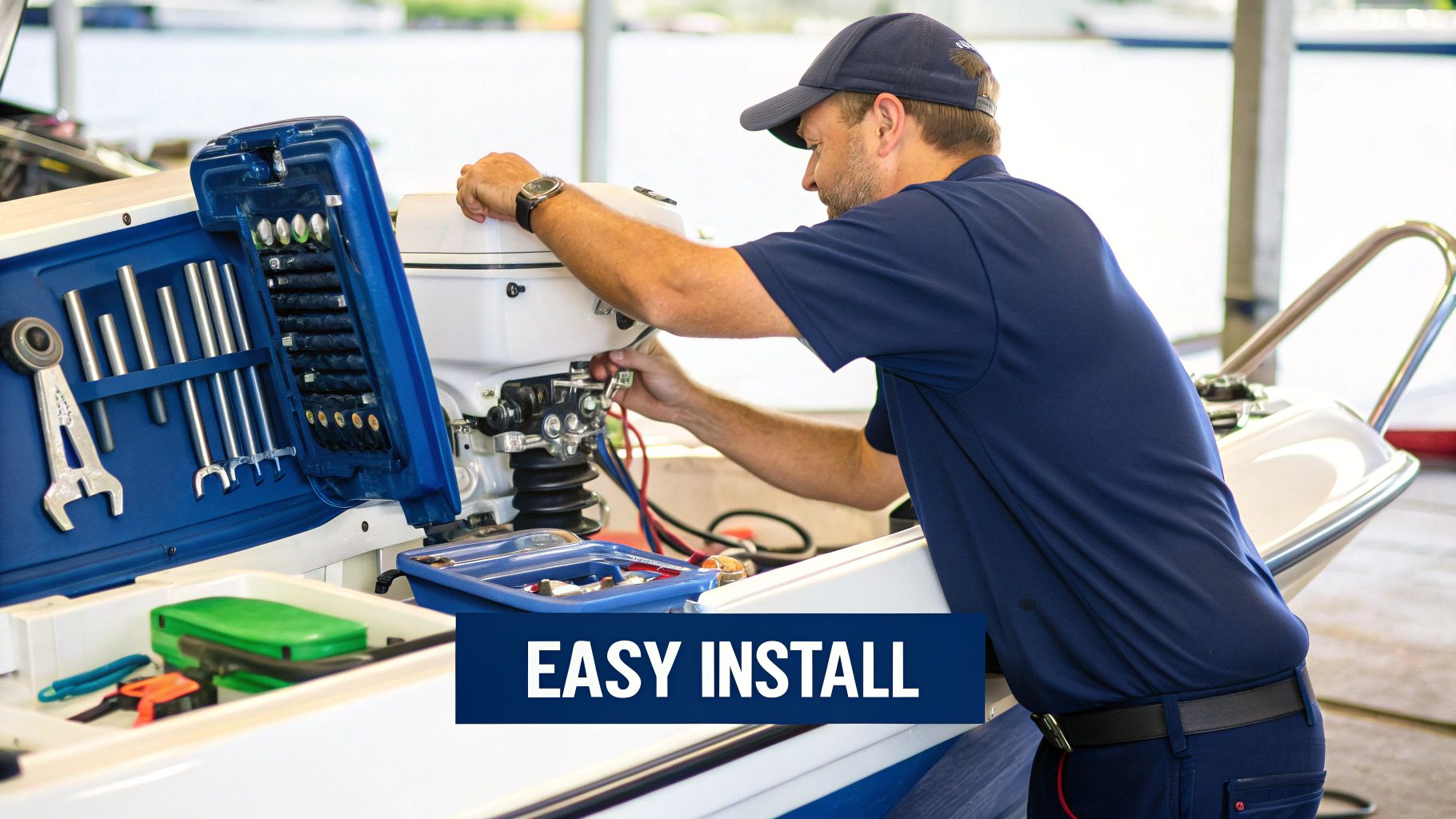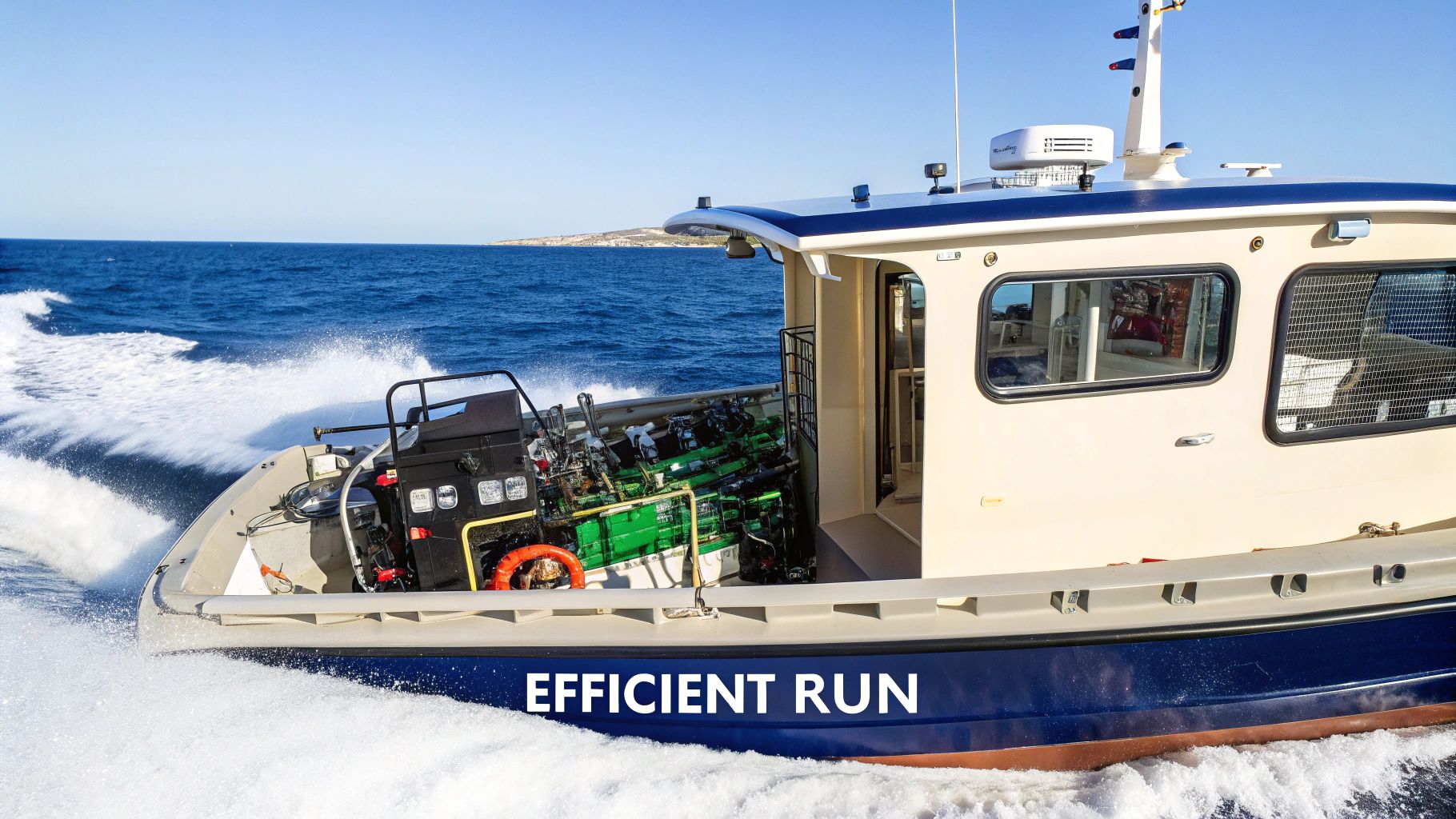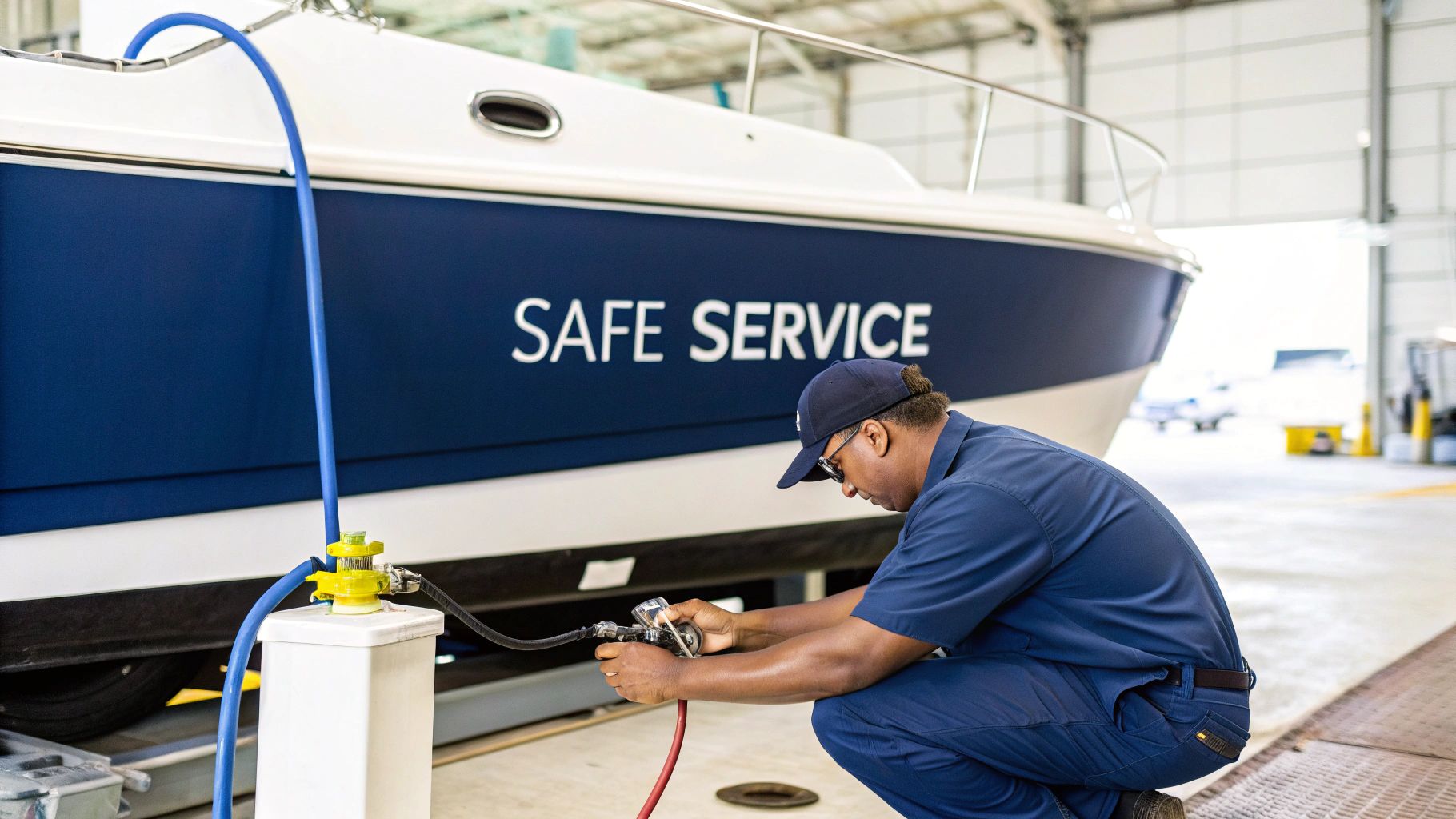The Hidden Hero: Understanding Your Boat Fuel Sending Unit

For many boat owners, the boat fuel sending unit remains a mystery until problems arise. This small but essential component is responsible for accurately measuring your fuel tank level and sending that information to your fuel gauge. Without a properly functioning unit, you risk running out of fuel on the water, a scenario every boater wants to avoid. Understanding how this unit works can make the difference between a smooth journey and a potential emergency.
How Does a Boat Fuel Sending Unit Work?
The boat fuel sending unit acts like a messenger between your fuel tank and your dashboard. It uses a float connected to a variable resistor. The float rises and falls with the fuel level, changing the resistor's resistance. This change is then interpreted by your fuel gauge as a specific fuel level.
A high resistance typically indicates a low fuel level, while a low resistance signals a full tank. Modern boat fuel sending units often incorporate more advanced electronic sensors. These sensors provide even more precise readings and are generally more durable.
The reliability of these units has historically been a concern. One of the earliest and most dependable designs is the WEMA type sender, known for its simplicity and durability. WEMA senders avoid placing electrical components inside the fuel tank, minimizing corrosion and malfunctions. They are often re-branded by other manufacturers, like Moeller Marine, further demonstrating their widespread acceptance. Their robust design and availability for various tank depths make them a popular choice. You can learn more about testing fuel senders here: Testing a Marine Fuel Sender.
Types of Boat Fuel Sending Units
Selecting the right boat fuel sending unit depends on several factors, including your boat type, tank size, and budget. Here's a look at some common types:
- Mechanical Float Type: This traditional type is known for its reliability and cost-effectiveness. It utilizes a float arm attached to a variable resistor.
- Electronic Sensors: These offer greater accuracy and better resistance to fuel contaminants. They commonly use pressure or ultrasonic technology.
- Capacitance Senders: These measure the change in capacitance as the fuel level fluctuates. They are known for accuracy and stability, even in rough seas.
Proper installation and maintenance are key to ensuring reliable performance. For more informative articles, check out our blog's sitemap.
Importance of Proper Installation and Maintenance
Correct installation is vital for accurate readings and leak prevention. A poorly installed unit can lead to inaccurate readings or even dangerous fuel leaks. Regular maintenance, such as checking for corrosion and ensuring the float moves freely, will significantly extend the life of your unit.
This proactive approach helps maintain accurate fuel level readings and prevents unexpected breakdowns. Preventative care can save you from costly repairs and frustrating situations out on the water. Ultimately, selecting and maintaining the right boat fuel sending unit contributes to a safer and more enjoyable boating experience.
Choosing Your Perfect Match: Boat Fuel Sending Unit Options
Finding the right boat fuel sending unit can feel a bit overwhelming. Choosing the wrong one can lead to inaccurate readings and even equipment failure. This guide will break down the different types of sending units, helping you make an informed decision for reliable performance on the water.
Understanding the Different Types
Several types of boat fuel sending units are available, each with pros and cons. Understanding these differences is key to making the right choice for your vessel.
-
Mechanical Float Type: This traditional design uses a float attached to a variable resistor. It's a simple and affordable option known for its durability. However, the mechanical components can wear out over time, particularly in rough conditions.
-
Electronic Sensors: Using advanced technologies like pressure or ultrasonic measurements, electronic sensors offer improved accuracy and resistance to fuel contaminants. These sensors are ideal for boaters who need precise fuel level monitoring.
-
Capacitance Senders: These senders monitor changes in capacitance as the fuel level changes. Known for accuracy and stability, even in choppy water, they tend to be more expensive than other options.
-
Reed Switch Senders: These units use a series of reed switches triggered by a magnet on the float. This setup delivers distinct levels of measurement, striking a balance between reliability and simplicity.
Factors to Consider When Choosing
Several factors influence your choice of a boat fuel sending unit.
-
Tank Shape and Size: Your fuel tank's dimensions will determine the type of sending unit you need. Some units are specifically designed for particular tank shapes or depths.
-
Material Compatibility: Fuel tanks are made from various materials like aluminum, steel, or plastic. Make sure the sending unit you choose is compatible with your tank's material to avoid corrosion or other problems.
-
Operating Conditions: Think about where you usually boat. Saltwater requires more durable, corrosion-resistant materials than freshwater. If you often encounter rough seas, a stable and accurate sensor like a capacitance or reed switch type might be a better choice.
-
Budget: Fuel sending units range in price, from affordable mechanical floats to pricier electronic options. Set a budget and pick a unit that delivers the best value for your money.
To help you compare, let's look at the different types of sending units in more detail.
Let's take a look at a table summarizing the key differences between these fuel sending unit types.
Comparison of Boat Fuel Sending Unit Types
| Sending Unit Type | Accuracy | Durability | Price Range | Installation Difficulty | Best For |
|---|---|---|---|---|---|
| Mechanical Float | Moderate | Moderate | Low | Easy | Basic applications, smaller boats |
| Electronic Sensors | High | High | Moderate to High | Moderate | Larger vessels, precise readings |
| Capacitance Senders | High | High | High | Moderate | Rough seas, critical fuel monitoring |
| Reed Switch Senders | Moderate to High | High | Moderate | Easy to Moderate | Reliable performance, balance of cost and accuracy |
This table provides a general overview. Specific product specifications can vary, so always check the manufacturer's details before making a purchase. Choosing the right sending unit ensures you have the information you need for safe and enjoyable boating.
Statistically, a fuel sending unit's performance is measured by its accuracy. For example, the 9800 series of reed switch probes by Rochester Sensors are known for precision, with specific resistance values at full and empty. These senders are tested for durability in harsh marine environments, making them a reliable choice.
You can also explore CLiX Fueling Products for more information on various fueling solutions. This resource can provide additional insights into choosing the best setup for your boat.
Making the Right Choice
Choosing the right boat fuel sending unit doesn't have to be complicated. By considering your tank's specifics, operating conditions, and budget, you'll find a unit that offers reliable fuel level monitoring. Having accurate fuel readings lets you plan trips better, manage fuel usage, and enjoy your time on the water with peace of mind.
Installing Your Boat Fuel Sending Unit: A Foolproof Guide

So, you've got your new boat fuel sending unit. Great! Now, it's time for the installation. This guide provides a step-by-step process to help you install it correctly. Proper installation ensures accurate fuel readings and prevents leaks, keeping you safe on the water. When choosing a fuel sending unit, understanding different valve types is important, much like a valve selection guide for general applications.
Safety First
Before starting, remember safety is key. Working with fuel can be dangerous. Always disconnect your boat's battery to prevent sparks. Make sure the area is well-ventilated to avoid fuel vapor buildup. Wear proper safety gear, like gloves and eye protection.
Gathering Your Tools
The right tools make installation easier. You'll need basic tools: screwdrivers, wrenches, and pliers. You’ll also need a sealant designed for fuel systems to prevent leaks. A fuel line disconnect tool can help remove fuel lines without causing damage.
Step-by-Step Installation Process
-
Step 1: Access the Fuel Tank: Find your fuel tank and remove the access panel. This might involve removing screws or bolts, depending on your boat.
-
Step 2: Disconnect the Old Sending Unit: Carefully disconnect the wiring connector and the fuel line from the old sending unit. Keep a rag handy to wipe up any spilled fuel.
-
Step 3: Remove the Old Sending Unit: Unscrew the locking ring holding the old unit to the tank. Carefully remove the unit and note the gasket or O-ring used for sealing.
Installing the New Sending Unit
Now you're ready to install the new unit.
-
Step 1: Prepare the New Unit: Install a new gasket or O-ring on the new sending unit. Apply a thin layer of fuel-resistant sealant for a leak-proof seal.
-
Step 2: Install the New Unit: Carefully put the new sending unit into the tank opening. Secure it with the locking ring, making it snug but not too tight.
-
Step 3: Connect the Fuel Line and Wiring: Reconnect the fuel line and wiring connector to the new unit. Check all connections are tight and secure.
-
Step 4: Test for Leaks: Before replacing the access panel, test for leaks. Turn on the fuel pump and check the connections. Even small leaks can be dangerous and need immediate attention.
Tank Material and Design Considerations
Different tanks might need specific installation techniques. Aluminum tanks, for instance, need special care to prevent corrosion. Use compatible sealants and hardware. Tanks with unusual shapes or internal baffles might need specific sending unit models. Always check the manufacturer’s instructions for your boat and tank.
Calibration and Testing
After installation, calibrate the new sending unit according to the manufacturer’s instructions. This ensures accurate fuel level readings. Finally, test the whole system by filling the tank and checking the gauge.
There's a growing global focus on fuel sending unit safety and accuracy. Advancements in non-contact sensors are reducing fire risks tied to traditional units. You can learn more about fuel gauge technology advancements. This focus on safety reflects updated regulations and consumer expectations for reliable performance.
This guide simplifies installing your boat fuel sending unit. By following these steps and precautions, you'll have a safe and successful installation, giving you confidence in your boat's fuel system every time you're on the water.
When Things Go Wrong: Boat Fuel Sending Unit Troubleshooting

A malfunctioning boat fuel sending unit can be a real headache, and even a safety hazard. But before you panic, remember that troubleshooting this crucial component is often easier than you think. This guide will walk you through the process of diagnosing and fixing common fuel sending unit issues.
Common Problems and Solutions
Fuel gauge problems aren't always caused by a faulty sending unit. The issue could lie elsewhere in the system, making it tricky to diagnose. A systematic approach is key to finding the culprit. Let's look at some common scenarios:
To help organize these common problems, their symptoms, potential causes, and solutions, refer to the table below.
Boat Fuel Sending Unit Troubleshooting Guide This table presents common fuel sender problems, their symptoms, likely causes, and recommended solutions.
| Problem | Symptoms | Possible Causes | Recommended Solutions |
|---|---|---|---|
| Fuel gauge reads empty or full regardless of actual fuel level | Needle stuck on "E" or "F", inaccurate readings | Faulty sending unit, damaged wiring, bad ground connection, malfunctioning gauge | Check wiring connections for corrosion or damage. Test the sending unit by disconnecting it and manually moving the float arm. If the gauge responds, the sending unit likely needs replacement. If not, suspect the gauge or wiring. |
| Fuel gauge fluctuates erratically | Needle jumps around, readings inconsistent | Loose wiring, failing sending unit, fuel sloshing, bad ground | Secure all wiring connections. Inspect the sending unit float arm for obstructions. Check the ground connection for the sending unit. |
| Fuel gauge reads inaccurately but consistently | Readings always off by a certain amount, but consistent | Sending unit calibration issue, incorrect sending unit for the tank | Consult your boat's manual or the sending unit manufacturer's instructions for calibration procedures. Verify you have the correct sending unit matched to your fuel tank’s dimensions. |
As you can see from the table, many issues can be addressed with simple checks and adjustments.
Testing Techniques
Even without fancy equipment, you can perform some simple tests that marine mechanics often use.
-
Direct Ground Test: Briefly touch the sending unit wire to a ground. If the gauge jumps to full, the problem is likely with the sending unit or its wiring. If the gauge doesn't move, suspect the gauge or its wiring.
-
Resistance Check: A multimeter helps measure the resistance of the sending unit. Check your sending unit's documentation for the expected resistance values and compare them to your multimeter reading. This helps confirm whether the sending unit is operating within the correct range.
Environmental Factors and Warning Signs
Several factors can impact the lifespan of your boat fuel sending unit. Corrosion is a major concern, especially in saltwater environments. Some sending units can also be affected by the ethanol present in modern fuels. Keep an eye out for early warning signs, like a sluggish gauge response or intermittent inaccurate readings. Addressing these minor issues promptly can prevent bigger problems down the road.
Temporary Fixes
Sometimes, problems arise while you're out on the water. Here are a couple of temporary solutions to help you get back to shore safely. If your fuel gauge is totally unreliable, track your engine hours and fuel consumption rate. This allows you to estimate your remaining fuel. You might find yourself tackling other boat plumbing projects after addressing the sending unit. For example, if you’re considering a faucet replacement, a guide like this one on Delta Faucet Replacement can be helpful. Ultimately, understanding your boat fuel sending unit makes your boating experience safer and more enjoyable. You can also check out CLiX Fueling's sitemap for more resources on fuel systems and related topics.
Extending Your Investment: Boat Fuel Sending Unit Maintenance

A reliable boat fuel sending unit can keep your boat running smoothly for years, even decades. But simple maintenance is often overlooked, leading to premature failure and unexpected problems out on the water. This section covers key maintenance practices, recommended by marine experts, to ensure your fuel sending unit continues working correctly.
The Impact of Fuel Quality
The quality of your fuel plays a surprisingly significant role in how long your boat fuel sending unit lasts. Contaminants and ethanol in the fuel can corrode the unit’s components. This can cause inaccurate fuel readings or even complete failure. Water in your fuel tank, for example, can cause rust and prevent the float from moving properly. Ethanol can also degrade seals and hoses within the sending unit.
Using high-quality fuel and adding a fuel stabilizer regularly are simple ways to protect your investment. This preventative measure is especially important for boats using ethanol-blended fuels.
Cleaning Techniques for Corrosion Prevention
Corrosion is a constant threat to marine equipment, especially fuel sending units. But using the wrong cleaning methods can actually do more harm than good. Harsh chemicals can damage the delicate internal parts of your sending unit.
A better approach is to use a gentle cleaning solution designed for marine fuel systems. A mild soap and water solution can often remove dirt and grime effectively without causing any harm.
Seasonal Maintenance: Active Use vs. Storage
How you maintain your boat's fuel sending unit depends on whether you're actively using your boat or storing it for a while. During periods of active use, regularly inspect the sending unit for any signs of damage or corrosion. Also, check the wiring connections to ensure they are secure and corrosion-free.
If you're storing your boat for an extended period, adding a fuel stabilizer is highly recommended. This helps prevent fuel degradation and protects your sending unit while it’s not in use, preventing potential problems when you’re ready to head back out on the water.
Establishing a Maintenance Schedule
Professional captains understand the importance of a detailed maintenance schedule. It minimizes the chance of unexpected equipment failures. You can follow their lead and create a similar schedule for your boat’s fuel sending unit. A simple logbook is an easy way to track inspections, cleanings, and repairs.
This log provides a useful record of the unit's performance. It can also help you predict when replacement might be necessary. For example, if you start noticing recurring issues, it's a good indication that it's time to consider a replacement. This proactive approach can prevent costly repairs and avoid potential emergencies on the water.
Beyond Basic Readings: Advanced Boat Fuel Monitoring
Traditional fuel gauges and basic boat fuel sending units give you the essentials, but imagine having a much more detailed picture of your fuel usage. Advanced fuel monitoring systems offer precisely that – deeper insights for boaters who want more control and efficiency on the water. It's about moving beyond a simple glance at the gauge and embracing a smarter approach to boating.
Integrating GPS and Fuel Consumption Data
Today's technology allows us to combine GPS data with fuel consumption, creating a powerful planning tool. These advanced systems track your boat's position and speed along with how much fuel you're using in real time. Think about knowing precisely how much fuel you need to get to your destination, factoring in current conditions and your planned route. This precision changes the game for fuel management and trip planning.
Real-Time Range Estimation
Combining GPS and fuel data allows for real-time range estimations. The system analyzes your fuel consumption and compares it to your remaining fuel, calculating how far you can travel. This allows you to adjust your speed or route to maximize your range, putting you firmly in control of your journey.
Remote Monitoring Capabilities
Wireless technology is bringing commercial-grade remote monitoring to recreational boating. You can now check your fuel levels from anywhere, using your smartphone or other connected device. This is particularly helpful if you store your boat off-site or want to keep tabs on fuel during longer trips.
Tangible Benefits of Upgrading
Boaters using advanced fuel monitoring systems report some significant advantages:
- Significant Fuel Savings: Understanding your fuel consumption lets you optimize speed and route, saving you money over time.
- Extended Engine Life: You avoid the risk of running low on fuel, which can damage your engine and shorten its lifespan.
- Improved Safety: Accurate fuel monitoring reduces the chance of getting stranded, enhancing your safety on the water.
Installation and Compatibility
While these advanced systems offer a lot, it's important to consider installation and compatibility. The process can vary depending on the system and your boat's current setup. Some systems work with existing boat fuel sending units, while others might need new sensors and wiring. Compatibility also depends on the type of vessel. It's always best to consult with a qualified marine technician to ensure proper integration with your boat's systems.
Advanced boat fuel monitoring systems are changing the way boaters manage resources and plan trips. They offer valuable data on fuel consumption, enabling real-time range estimations and remote monitoring. The benefits are clear: fuel savings, longer engine life, increased safety, and more informed decisions on the water. Ready for stress-free fueling and precise monitoring? Upgrade with CLiX Fueling Solutions for a safer, more efficient boating experience. Visit CLiX Fueling to learn more.












